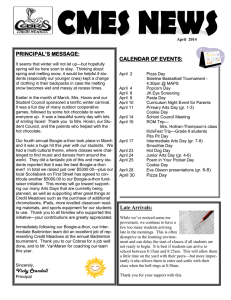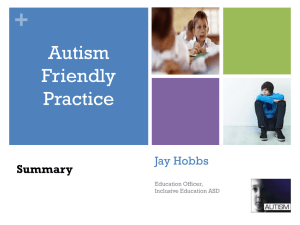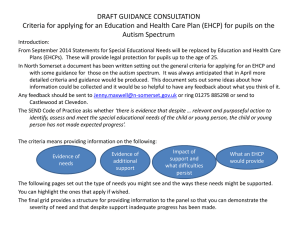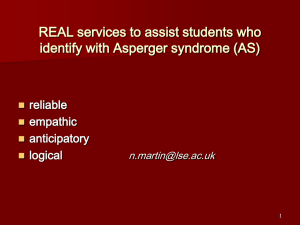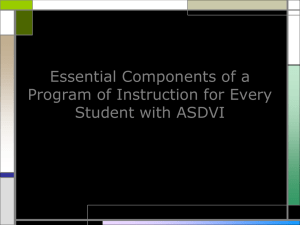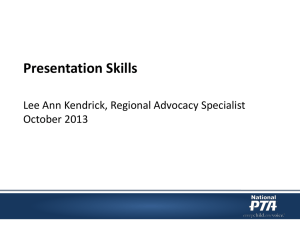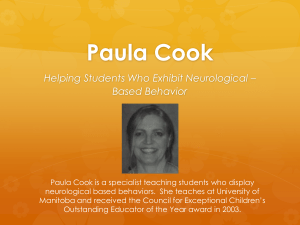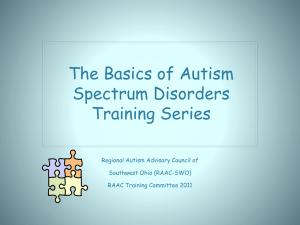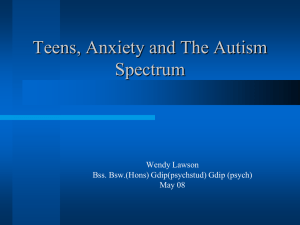Strategies to Support Students with Autism MCS
advertisement
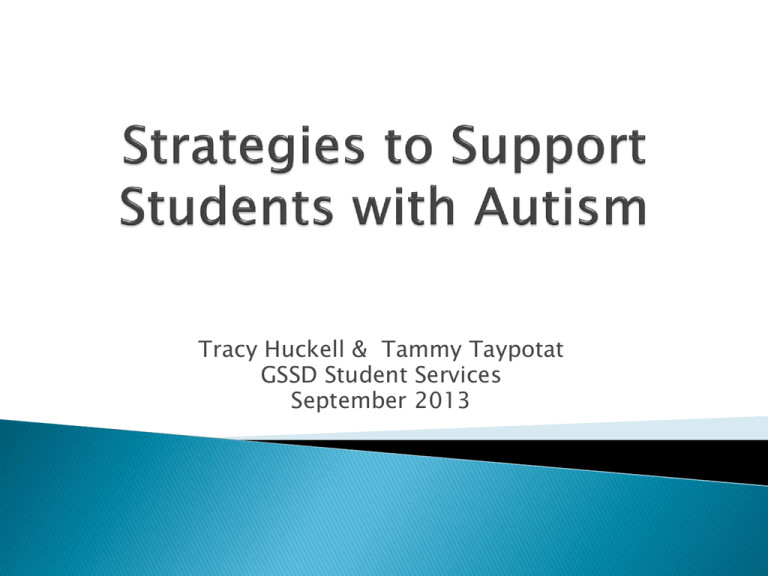
Tracy Huckell & Tammy Taypotat GSSD Student Services September 2013 Autism/Asperger Syndrome Definitions Characteristics of Autism or ASD (Autism Spectrum Disorder) Proactive Strategies for the Classroom Rage Cycle and Strategies to Support Students and Staff - video Understanding Students with ASD Questions Autism Spectrum Disorder is a pervasive developmental disorder characterized by: ◦ impairments in communication, social interaction, and sensory processing ◦ repetitive and stereotypical patterns of behavior, interests and activities (American Psychiatric Association). ‘Spectrum’ indicates the symptoms can be present in a variety of combinations and can range from mild to severe According to DSM-IV (1994) criteria, an Asperger’s diagnosis must meet criteria for social impairment and repetitive actions, but have normal cognitive and language development. Characterized by impairments in social language ◦ appear socially awkward, have difficulty with empathy, and misinterpret social cues. ◦ Often talk incessantly about a favorite topic and have difficulty switching to another topic ◦ Conversation can appear overly formal ◦ Individuals with AS want to interact with others despite their lack of skills May have difficulty with motor coordination, balance, dexterity, and handwriting May be hypersensitive to some stimuli and engage in unusual behavior to regulate Average or above average intelligence and may appear quite capable, but have relative weaknesses in abstract thought, problem solving, and making inferences or judgements. This rigid thinking causes difficulty in adapting to change or failure, and difficulty learning from mistakes or errors. Students with AS often give the impression they understand more than they do due to their advanced vocabulary, formal tone of voice, and rote-like responses May be inattentive, easily distracted and be diagnosed with ADHD at some point Severe social anxiety is also commonly associated with AS. Appear overly controlling to those around them but that is their strategy for reducing anxiety and the unknown Impairments in Communication ◦ Range from being non-verbal to having extensive vocabularies with deficits in the use of social language ◦ Difficulty with facial expression, use of gestures, imitation, eye contact, shared focus of attention ◦ May have repetitive speech patterns and perseverate on a favorite topic ◦ Difficulty with pragmatics (social use of language) – problems initiating conversation, maintaining a topic, interrupting, rigidity, multiple meanings of words, and understanding subtle social messages and rules ◦ May talk with exaggerated inflections or a monotone style, stand too close or too far away, stare intently for long periods of time or fail to make eye contact, or fail to use gestures or facial expressions that accompany verbal messages ◦ Difficulty explaining how they feel or why they did something ◦ Interpret phrases very literally – ‘pull up your socks’ Impairments in Social Interaction ◦ Difficulty reading and understanding social situations ◦ Limited social interaction does not necessarily reflect a lack of desire to interact with others, they just don’t have the skills ◦ Difficulty attending to relevant social cues and shifting attention when necessary ◦ Difficulty with appropriate use of nonverbal behavior and reading this behavior in others ◦ Difficulty understanding their own feelings and sensing what others are feeling ◦ Difficulty understanding different points of view or the perspective of others – struggle to understand others’ feelings, desires, and intentions (easy targets for teasing and bullying) ◦ May engage in excessive or inappropriate laughing or giggling ◦ Difficulty connecting their actions to other’s reactions ◦ Difficulty with turn taking and politeness Unusual Behaviors and Interests ◦ Restricted range of interests with preoccupations ◦ Repetitive motor mannerisms such as hand flapping, rocking, spinning, walking on tiptoes, spinning objects – often due to hyper or hypo sensitivity ◦ Resistant to change ◦ Excitement in a student with ASD often causes the same reaction as stress. When overly excited the student cannot monitor his/her behavior and may lose control/escalate Attention Difficulties ◦ Difficulty disengaging and shifting attention from one stimuli to the next ◦ Impairment in ability to share attention – joint attention ◦ May have a short attention span and be distracted by stimuli that doesn’t bother peers Cognitive Deficits and Learning Styles ◦ May have deficits in: attending to relevant cues and information receptive and expressive language impairments especially in abstract and social language concept formation and abstract reasoning ability to plan, organize and problem solve Often select one problem solving strategy and use it consistently regardless of the situation or outcome – can trigger escalations when student becomes frustrated or confused as to why the strategy they chose is not working ◦ May have strengths regarding: Rote memory and ability to recall simple information but difficulties applying more complex information Putting puzzles together and often perform well with spatial, perceptual and matching tasks Remembering information presented visually – some ‘think in pictures’ Unusual Responses to Sensory Stimuli ◦ Responses to sensory stimulation vary from hyposensitive (high tolerance for pain) to hypersensitive (aggravated by tags in clothing, preference for sweat pants over jeans, seams in socks hurt their toes) ◦ May crave pressure which often has a calming effect ◦ Some are hypersensitive to odors, bright lighting, and noise (even the hum of florescent lights) ◦ Individuals with severe sensory processing problems may go into total shutdown or experience escalations when they become overstimulated. Self-stimulating behaviors are often used to help the individual calm down by generating a self-controlled, repetitive stimulus Anxiety ◦ Many individuals with autism experience anxiety due to their difficulties with: being able to express feelings, thoughts, emotions processing sensory information fear of some sources of sensory stimulation the need for predictability and having to cope with changes they may not have been prepared for understanding social situations a sense of a loss of control misperception of social events rigidity in moral judgement that results from a very concrete sense of right/wrong In contrast to peers, students with AS often do not reveal their stress through voice tone and overt agitation which can result in escalation to the point of crisis because others are unaware of their discomfort or anxiety, and because of their inability to predict, cope, and manage uncomfortable situations Use of visuals ◦ Aids for organization such as daily schedules, activity checklists, day to day class agenda, choice boards, first/then routines, steps to complete a task/problem, written instructions for learning new info, story maps etc. ◦ Strategies for organizing the environment such as labelling objects, containers for homework etc. ◦ Supports for social development such as posting rules and routines, and using social stories to teach social skills ◦ Allows decreased reliance on teacher or EA – gradual release model to teach use of visuals to complete tasks Key is to consider when planning ‘how can this information be presented in a simple visual format?’ Provide a structured and predictable classroom environment ◦ Provides consistency and clarity ◦ Reduces anxiety as students know what to expect and can anticipate what comes next ◦ Alternate familiar successful activities with less preferred activities ◦ Alternate large group activities with calming activities ◦ Implementation of a sensory diet that allows student to decrease sensory overload and calm before becoming anxious or escalated – proactive vs. reactive Provide positive specific praise about what the student does right or well Use concrete examples and hands-on activities when teaching abstract ideas Avoid long strings of verbal information – break down instructions and use visual aids Provide opportunities for choice - ways to show what they know, order of activities etc. Use first/then Use meaningful reinforcers that student can choose from Plan and present tasks at an appropriate level of difficulty – too difficult leads to anxiety and sometimes escalations due underdeveloped coping skills Note tasks and activities that create frustration and examine environment for sounds and activities that result in sensory overload Provide a calm, quiet designated area the student can go to relax when they are feeling anxious or beginning to escalate – set this up ahead of time, discuss expectations and practice using this space and be consistent from teacher to teacher/class to class with this Plan for transitions and prepare the student for change through use of visual schedules (that highlight changes and what comes next) and social stories (that teach the student about new situations) Give ample time warnings (5 min left, 2 min left etc) and use visual timer Ensure all teachers set and uphold similar expectations to provide structure and consistency Expectations need to be translated into rules and routines students understand Reduce the amount of visual stimuli in the classroom especially in direct line of view of student with Autism or AS Social Interaction ◦ Provide opportunities for meaningful contact with peers who have appropriate social behavior ◦ Teach appropriate social behavior, problem solving and coping skills explicitly like academic skills – step by step with gradual release and lots of opportunity for practice Managing Challenging Behavior ◦ ABCs of Behavior – Antecedent (what happened before the behavior), Behavior description/frequency/intensity, Consequence (what happened as a result of the behavior/reaction) ◦ Data collected should be analyzed to identify patterns, triggers, and possible reinforcers ◦ Consider the function of the behavior: Gain attention Tangible – get something Escape from an unpleasant situation or task Self-regulation or tension release Behavior Strategies ◦ Provide clear expectations for behavior and use visual aids to help student understand what is expected along with reinforcement Teaching and Reinforcing Alternate Behaviors ◦ Once the function of the behavior has been identified, the team should identify an alternative/more appropriate behavior that serves the same function rather than escalating and storming out, the student identifies he is escalating and uses a break card to request a break Instead of yelling or whining when frustrated, the student learn to say, “I need help with this”. Observe the student for signs of increasing anxiety and environmental factors that could be contributing to the anxiety Teach the student to say “I need a break” or use a break card. Provide opportunities for relaxation in brief 5 – 10 min periods. Student can go to a break area in class or another room, listen to music that is calming, use of fidget. Discuss with student what is calming for them. Students with AS sometimes exhibit a sudden onset of aggressive or oppositional behavior Seem to escalate without being provoked and appears to come out of nowhere - students with ASD struggle to communicate verbally or nonverbally the early signs of stress Meltdowns do not occur without warning – the pattern of behaviors are there but are often very subtle (what have you noticed?) The rage cycle is not a time to teach new skills – only to support the student in utilizing skills he/she already knows and can use fluently Escalations follow three-stage cycle: ◦ Rumbling Stage ◦ Rage Stage ◦ Recovery Stage Initial stage May clear throat, grimace, lower voice, tense muscles, tap feet, bite nails or lip, or erase paper until a hole appears – easy to ignore these seemingly minor behaviors May emotionally or physically withdraw May challenge authority, swear, and attempt to engage in power struggle Imperative that staff intervene at this stage without becoming part of the struggle ◦ Staff need to be flexible as the student cannot ◦ Interventions at this time are band-aids to allow the student and staff to survive the cycle – this is not a teachable moment ◦ It’s imperative that staff know which behaviors/reactions are likely to escalate the child from the rumbling stage to the rage stage ◦ Staff must remain calm, project calmness, minimalize verbalizations, use a quiet voice and avoid power struggles ◦ Primary focus is preventing occurrence of the rage stage and may mean leaving an assignment unfinished Remove the student from the environment they are experiencing difficulty in – send them on an errand, use break card etc. Move near the student in a non-confrontational supportive way Using a prearranged signal to let the student know you are aware he/she is under stress (tapping desk) as a cue to employ a strategy (such as squeezing a stress ball, deep breathing, or taking a break) Redirect student to their schedule to remind them of a preferred activity or reinforcement that is next on the schedule Redirect the student by discussing something that is of special interest to the student which can often be calming Diffuse tension through humor or a joke the student would like and understand Signal student to take a break or go to home base room – should be calming positive and neutral environment with a selection of items/activities that are calming to student Students can also take class work to home base to complete after a brief respite to calm Home base can also be used for check-in/check-out and to introduce changes to the typical routine Acknowledging student difficulty – staff briefly support the verbalizations of the student and help them complete the task they are struggling with to avoid an escalation eg. “Yes, this problem is tough. Let’s start with the first step” and provide the scaffolded support the student requires. Just walk and don’t talk – silence is important as the student in a rumbling stage will likely react to any statement and may misinterpret it. The child can vent at this time without fear of discipline and the adult should remain calm, show as little reaction as possible and never be confrontational Goal is to avoid rage stage and help them regain control of emotions while retaining respect and dignity Use of the Incredible 5 Point Scale to identify where they are at between 1 and 5 and prompt them to choose a prearranged strategy (this need to be taught and practiced prior to use in rumbling stage) Self calming – when calm/stabilized, work with the student to develop a calming routine that works for them and have it available visually (pictures or words) to refer to. eg: ◦ ◦ ◦ ◦ ◦ Take three long breaths Stretch your arms over your head, down and up again Rub your hands together and count to 3 Rub your thighs and count to 3 Take another long breath Raising voice or yelling Making assumptions Acting superior Preaching or nagging Backing the student into a corner Pleading or bribing Insisting on having the last word or that the adult is right Bringing up unrelated events Using sarcasm Using tense body language Holding a grudge Making unsubstantiated accusations Using unwarranted physical force Commanding, demanding, dominating Using degrading, insulting, or humiliating putdowns Student acts impulsively, emotionally and sometimes explosively, and can include hitting, screaming, biting, kicking, self-injury or destroying property Once it begins, this stage often must run its course Emphasis should be placed on student, peer and staff safety Get the child to home base before this occurs if possible. If not, remove other students. Redirection at this stage often escalates behavior as the student can’t process the demands placed on him/her Refer to previously developed behavior plans that outline NVCI team and protocol regarding who to call, removal of other students, and providing restraint only if the child is hurting others or him/herself. Staff should disengage emotionally so as not to escalate as well and should remain calm and quiet Protect the student, others and the environment Don’t discipline or be confrontational – be calm and quiet Remove the audience Follow the plan and obtain assistance Use few words – remember less is more Prevent a power struggle Be flexible – the student cannot Don’t take things personally Disengage emotionally Be conscious of your verbal cues Take deep breaths Allow to sleep if necessary Support use of relaxation techniques Do not refer to rage behavior Support with structure Consider the student ‘fragile’ Determine appropriate option for student: ◦ Redirect to successful activity or special interest ◦ Provide space and further rest time if needed Monitor to see if student is ready to learn Do not make excessive demands Students with AS/Autism often cannot fully remember what occurred during the rage stage and become apologetic Some become sullen, withdraw or deny that inappropriate behavior occurred, while others are so physically exhausted they need to sleep Students are not ready to learn at this stage – discussion of behavior at this time could lead to further escalations Focus on helping them get back into the day’s routine beginning with a highly motivating task that can easily be completed (activity related to their special interest) Some may require engagement in further relaxation techniques or sensory activities Teacher needs to take time to regroup and discuss what occurred with a colleague (debrief) It’s essential for school teams to recognize the fragile emotional state of students on the ASD spectrum and adapt the environment to meet their needs ◦ Become skilled at recognizing the initial behavior signs of stress and anxiety ◦ If the student is doing fine during the day but parents report they fall apart at home frequently, stress may be building during the school day and when they get home they let go of the pressure that is bottled up ◦ When student is in a fragile emotional state (precipitating events), temporarily reduce expectations to help them through a difficult day without escalating Determine stressors in the school environment (substitute teacher, changes to regular schedule, unrealistic demands, long assignment with no idea how to begin, information presented to fast or not in visual format, difficulties working with peers etc.) Increase supports and reduce stressors Identify specific situations that routinely lead to tantrums, rage, or meltdowns and modify environment to reduce these situations When in fragile emotional state, provide more opportunities to engage in high interest activities or those that emphasize strengths Increase use of home base or break room if needed – proactive rather than reactive Balance stressors and learning – as student becomes more stable, gradually increase regular demands while consistently monitoring emotional state Always consider whether the student has the skills to perform a task. If not, develop a plan to teach the prior skills required. Students with ASD do not want to engage in escalations, rage or meltdowns. The rage cycle may be the only way they know how to cope with stress and other emotions The best intervention is prevention – breaks, adequate support, clear and appropriate expectations, teaching the skills that are lacking, motivators/reinforcement for completion of tasks and learning new skills Ministry of Education (1999). Teaching Students with Autism: A Guide for Educators Myles, B. S. & Southwick, J. (2005). Asperger Syndrome and Difficult Moments: Practical Solutions for Tantrums, Rage and Meltdowns Myles, B.S. (2005). Children and Youth with Asperger Syndrome.
